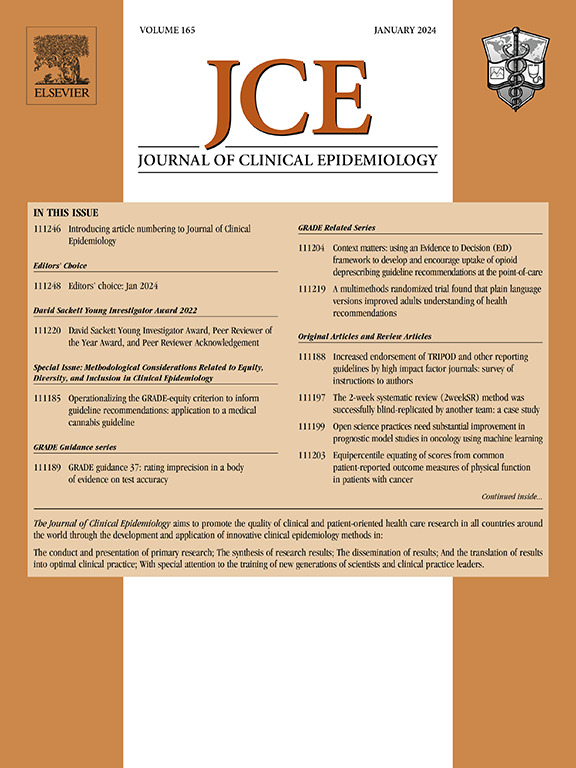欧洲和北美顶级医学期刊作者中持续存在的种族差异:系列横截面分析。
IF 7.3
2区 医学
Q1 HEALTH CARE SCIENCES & SERVICES
引用次数: 0
摘要
研究目的我们研究了过去二十年中在主要医学期刊上发表研究文章的作者的种族来源:我们对 2002 年、2012 年和 2022 年在《英国医学杂志》、《柳叶刀》、《美国医学会杂志》和《新英格兰医学杂志》上发表原创研究文章的第一作者和最后作者进行了连续横断面分析。主要结果是作者比例随时间推移在种族(盎格鲁人、西北欧人、西南欧人、亚洲人、阿拉伯人和中东人、非洲人)、性别(男性、女性)和所属机构方面的变化(以百分点表示):大多数作者是盎格鲁后裔(44%),尽管非欧洲作者的比例在 2002 年至 2022 年期间有所增长。随着时间的推移,东亚、南亚以及阿拉伯和中东裔作者所占比例越来越大,增加了 3 到 6 个百分点,而非洲裔作者没有增加。增长是有性别区分的,非欧洲裔男性作为第一作者和最后作者增长了 8 个百分点,但非欧洲裔女性仅作为最后作者增长了 5 个百分点。大多数非欧洲裔作者隶属于北美(42.9%)或欧洲(22.4%)机构,而来自其他机构的非欧洲裔作者没有随时间推移取得有意义的进步:结论:随着时间的推移,主要医学期刊作者的种族多样性有所提高,但非欧洲裔男性占了大部分。结论:随着时间的推移,顶尖医学期刊作者的种族多样性有了一定程度的提高,但非欧洲裔男性的进步最大。本文章由计算机程序翻译,如有差异,请以英文原文为准。
Persistent ethnic disparities in authorship within top European and North American medical journals: a serial cross-sectional analysis
Objectives
We examined the ethnic origin of authors who published research articles in leading medical journals over the past 2 decades.
Study Design and Setting
We carried out a serial cross-sectional analysis of first and last authors who published original research articles in the British Medical Journal, Lancet, Journal of the American Medical Association, and New England Journal of Medicine in 2002, 2012, and 2022. The main outcome was the change in proportion of authors over time according to ethnic origin (Anglo, North/West European, South/West European, Asian, Arab and Middle Eastern, African), gender (male, female), and institutional affiliation in percentage points.
Results
Most authors were of Anglo descent (44%), although the proportion of non-European authors grew between 2002 and 2022. East Asian, South Asian, and Arab and Middle Eastern last authors accounted for a greater proportion of authors over time, gaining between 3 and 6 percentage points, while African authors made no gains. Gains were gender-specific, with non-European men gaining 8 points as first and last authors, but non-European women gaining 5 points as last authors only. Most non-European authors were affiliated with North American (42.9%) or European (22.4%) institutions, while non-European authors from other institutions did not make meaningful gains over time.
Conclusion
Ethnic diversity of authors in leading medical journals has increased somewhat over time, but non-European men account for most of the gains. Non-European women have yet to make comparable advancement as authors.
求助全文
通过发布文献求助,成功后即可免费获取论文全文。
去求助
来源期刊

Journal of Clinical Epidemiology
医学-公共卫生、环境卫生与职业卫生
CiteScore
12.00
自引率
6.90%
发文量
320
审稿时长
44 days
期刊介绍:
The Journal of Clinical Epidemiology strives to enhance the quality of clinical and patient-oriented healthcare research by advancing and applying innovative methods in conducting, presenting, synthesizing, disseminating, and translating research results into optimal clinical practice. Special emphasis is placed on training new generations of scientists and clinical practice leaders.
 求助内容:
求助内容: 应助结果提醒方式:
应助结果提醒方式:


